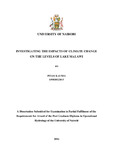| dc.description.abstract | Lake Malawi is a shared transboundary water resources among Tanzania, Mozambique and Malawi. The lake is located in the southern east Africa between latitude 9° S and 15° S and longitude 34.68° E and after Lake Victoria and Tanganyika it‟s the third largest Lake in Africa. Levels of the lake have significantly dropped over recent years raising fears on water resources development and management as the lake provides about 95% of hydropower generation through the Shire River system, navigation services, water supply and irrigation opportunities. The study examined the impacts of climate change on the levels of Lake Malawi and specifically analysed trends on climatological parameters, the inflow and outflow from the lake, lake levels, and simulated the water yield into Lake Malawi up to 2100. The data used in this study comprised of hydro-meteorological data sets from line institutions, Global Climatic Models (GCM) data the RCP4.5 scenarios and spatial data for the model. To achieve the main objective, the study carried out trend analysis of climatological parameters in decadal sets, correlation analysis of rainfall and lake levels, correlation of lake levels and outflow; SWAT modelling to simulate the water yield into the lake; and determined future climate impact on the levels of Lake Malawi. The results of the study showed that the lake is very sensitive to climate variations where the cyclic fluctuations in levels are largely subjective to annual rainfall patterns. Temperature over Lake Malawi is increasing whereas evaporation shows a decreasing trend. Rainfall has been varying over time but the long term trend showed a decreasing trend similar to the runoff inflow into the Lake. Lake levels showed a significant drop as well as the outflow. The future projection showed water yield is anticipated to even drop as simulated by the model. Determining the Impacts of climate change on the future levels based on the baseline data from 2006 to 2035, the near future from 2036 – 2065 and the far future 2066 to 2095 the study showed that the water yield will reduce by 8.84%, hence levels are also expected to drop in future. Based on these future projections the study recommends further studies on strategies for climate change resilient and adaptation on the economic impact the levels have on human livelihood. Further studies on the decreasing evaporation over the lake while temperatures are rising would further provide better assessment of the impacts of climate change on the lake levels. | en_US |



